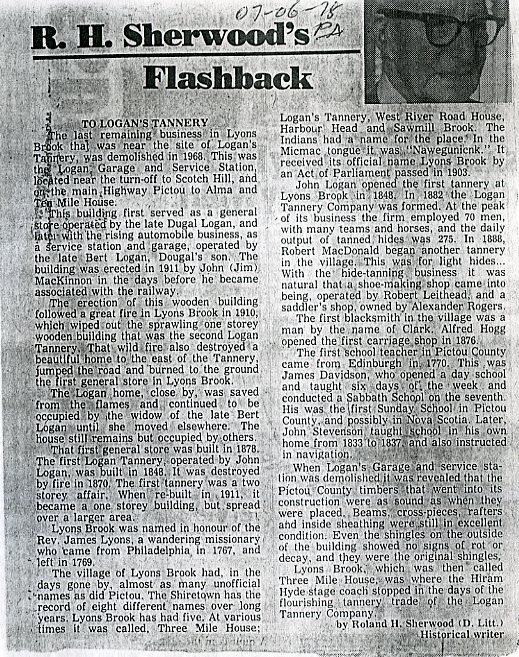
- H. Sherwood’s
Flashback
TO LOGAN’S TANNERY
The last remaining business in Lyons Brook was near the site of Logan’s Tannery, was demolished in 1968. This was the Logan Garage and Service Station, located near the turn-off to Scotch Hill and on the main Highway Pictou to Alma and Ten Mile House.
This building first served as a general store operated by the late Dugal Logan, and later with the rising automobile business, as a service station and garage, operated by the late Bert Logan, Dougal’s son. The building was erected in 1911 by John (Jim) MacKinnon in the days before he became associated with the railway.
The erection of this wooden building followed a great fire in Lyons Brook in 1910, which wiped out the sprawling one storey wooden building that was the second Logan Tannery. That wild fire also destroyed a beautiful home to the east of the Tannery, jumped the road and burned to the ground the first general store in Lyons Brook.
The Logan home, close by, was saved from the flames and continued to be occupied by the widow of the late Bert Logan until she moved elsewhere. The house still remains but occupied by others.
The first general store was built in 1878. The first Logan Tannery, operated by john Logan, was built in 1848. It was destroyed by fire in 1870. The first tannery was a two storey affair. When re-built in 1911, it became a one storey building, but spread over a larger area.
Lyons Brook was named in honour of the Rev. James Lyons, a wandering missionary who came from Philadelphia in 1767, and left in 1769.
The village of Lyons Brook had, in the days gone by almost as many unofficial names as did Pictou. The Shiretown has the record of eight different names over long years. Lyons Brook has had five. At various times it was called, Three Mile House; Logan’s Tannery, West River House, Harbor Head and Sawmill Brook. The Indians had a name for the place. In the Micmac tongue it was “Nawegunicnk.” It received its official name Lyons Brook by an Act of Parliament passed in 1903.
John Logan opened the first tannery at Lyons Brook in 1848. In 1882 the Logan Tannery Company was formed. At the peak of its business the firm employed 70 mean, with many teams and horses, and the daily output of tanned hides was 275. In 1888, Robert MacDonald began another tannery in the village. This was for light hides. With the hide tanning business it as natural that a shop making shoes came into being, operated by Robert Leithead, and a saddler’s shop, owned by Alexander Rogers.
The first blacksmith in the village was a man by the name of Clark. Alfred Hogg opened the first carriage shop in 1876.
The first school teacher in Pictou County came from Edinburgh in 1770. This was James Davidson, who opened a day school and taught six days of the week and conducted a Sabbath School on the seventh. He was the first Sunday school in Pictou County, and possibly Nova Scotia. Later, John Stevenson taught school in his own home from 1833 to 1887, and also instructed in navigation.
When Logan’s Garage and service station was demolished it was revealed that the Pictou County timbers that went into its construction were as sound as when they were place. Beams cross- pieces, rafters and inside sheathing were still in excellent condition. Even the shingles on the outside of the building showed no signs of rot or decay, and they were the original shingles.
Lyons Brook, which was then called Three Mile House, was then called Three Mile House, was where the Hiram Hyde stage coach stopped in the days of the flourishing tannery trade of the Logan Tannery Company.
By Roland H. Sherwood (D. Litt.)
Historical Writer
Vault Roland Sherwood File
| File number: | 01-597.10c |
| Contributor: |
|
| Tags: | Logan's tannery, Lyons Brook, Dugal Logan, Bert Logan, John McKinnon, Rev.James Lyons, John Logan, Robert Macdonald, Robert Leithead, Alexander Rodgers, Alfred Hogg, James Davidson, John Stevenson, Roland Sherwood, Pictou |
| Views: | 1602 |
| Uploaded on: | September 14, 2016 |